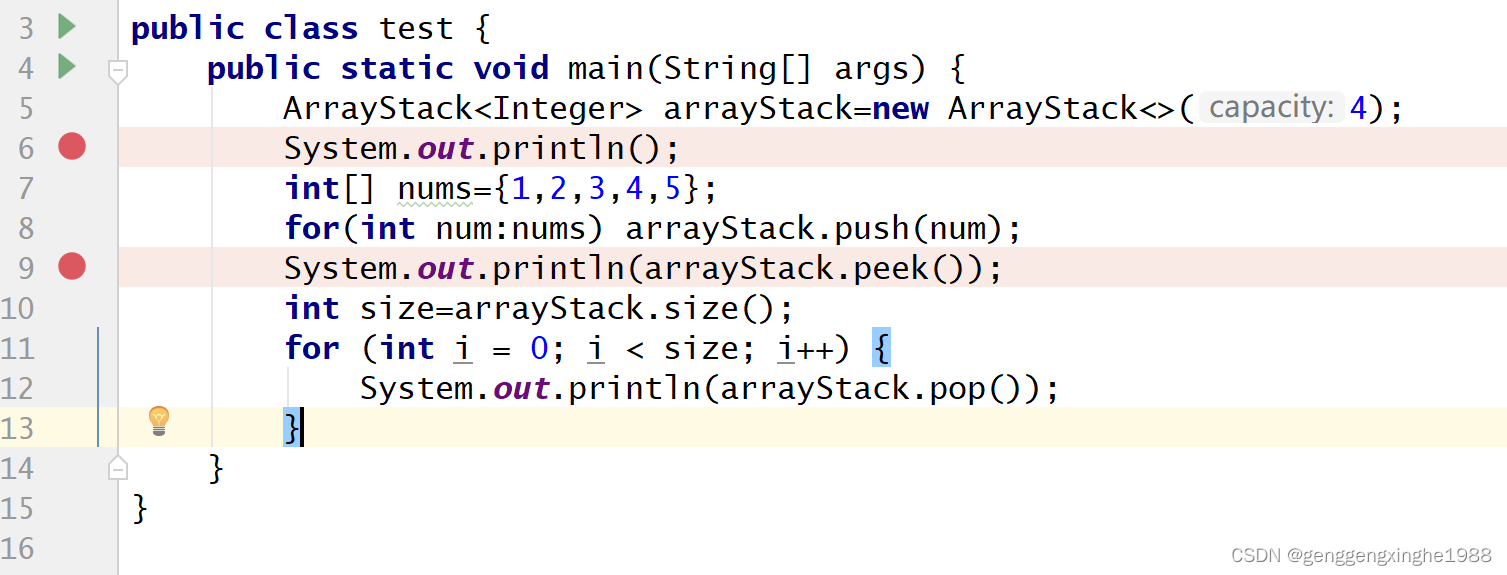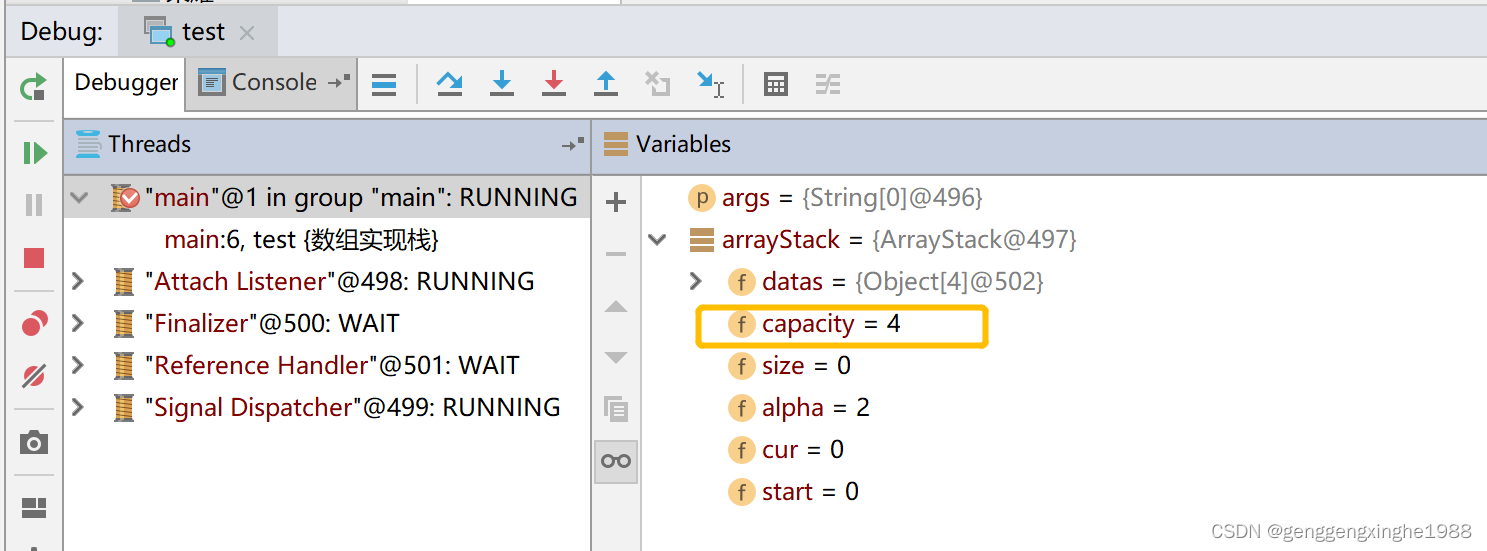一、手写生产者与消费者
1.2.0与1.0比较
- Lock 替代 synchronized
- lock.await() 替代 object.wait()
- lock.signalAll() 替代 object.notifyAll()
2.2.0版代码
/**
* 题目:一个初始值为0的变量,两个线程对其交替操作,一个加1,一个减1,来5轮
*
* 口诀:
* 1.线程操作资源类 --> 编写方法
* 2.判断 干活 通知 --> await() 和 signalAll()
* 3.防止虚假唤醒机制 --> 使用 while 判断,而不是 if
*/
public class ProdConsumer_TraditionDemo {
public static void main(String[] args) {
ShareData shareData = new ShareData();
new Thread(() -> {
for (int i = 1; i <= 5; i++) {
try {
shareData.increment();
} catch (Exception e) {
e.printStackTrace();
}
}
}, "AAA").start();
new Thread(() -> {
for (int i = 1; i <= 5; i++) {
try {
shareData.decrement();
} catch (Exception e) {
e.printStackTrace();
}
}
}, "BBB").start();
}
}
// 资源类
class ShareData {
private int number = 0;
private Lock lock = new ReentrantLock();
private Condition condition = lock.newCondition();
public void increment() throws InterruptedException {
lock.lock();
try {
//1 判断
while (number == 1) {
//等待,不能生产
condition.await();
}
//2 干活
number++;
System.out.println(Thread.currentThread().getName() + "\t" + number);
//3 通知唤醒
condition.signalAll();
} catch (Exception e) {
e.printStackTrace();
} finally {
lock.unlock();
}
}
public void decrement() throws InterruptedException {
lock.lock();
try {
//1 判断
while (number == 0) {
//等待,不能生产
condition.await();
}
//2 干活
number--;
System.out.println(Thread.currentThread().getName() + "\t" + number);
//3 通知唤醒
condition.signalAll();
} catch (Exception e) {
e.printStackTrace();
} finally {
lock.unlock();
}
}
}
(3).synchronized与Lock的差别
1)实现方式:
- synchronized是关键字属天JVM层面,synchronized的语义底层是通过一个monitor的对象来完成,其实wait()、notify()等方法也依赖于monitor对象,这就是为什么只有在同步的块或者方法中才能调用wait()、notify()等方法,否则会抛出java.lang.IllegalMonitorStateException的异常的原因
- Lock是具体类(java.util.concurrent.Locks.Lock)是api层面的锁
2)使用方法
- synchronized 不需要用户去手动释放锁,当synchronized代码执行完后系统会自动让线程释放对锁的占用
- ReentrantLock则需要用户去手动释放锁着没有主动放锁,就有可能导致出现死锁现象。需要lock()和unlock()方法配合try{ }finally{ }语句块来完成。
3)等待是否可中断
synchronized不可中断,除非抛出异常或者正常运行完成
ReentrantLock 可中断
- 设置超时方法 trylock(long timeout,TimeUnit unit)
- LockInterruptibly()放代码块中,调用interrupt()方法可中断
4)加锁是否公平
- synchronized非公平锁
- ReentrantLock两者都可以,默认公平锁,构造方法可以传入boolean值,true为公平锁,false为非公平锁
5)精准唤醒
ReentrantLock用来实现分组唤醒需要唤醒的线程们,可以精确唤醒,而不是像synchronized要么随机唤醒一个线程要么唤醒全部线程
2、阻塞队列版
(1)为什么用阻塞队列
- 不需要手动进行wait()、notify()
- flag为true就生产和消费,为false就停止生产和消费
(2)代码
/**
* volatile/CAS/atomicInteger/BlockQueue/线程交互/原子引用
*/
public class ProdConsumer_BlockQueueDemo {
public static void main(String[] args) throws Exception {
MyResource myResource = new MyResource(new ArrayBlockingQueue<>(10));
new Thread(() -> {
System.out.println(Thread.currentThread().getName() + "\t 生产线程启动");
try {
myResource.myProd();
} catch (Exception e) {
e.printStackTrace();
}
}, "Prod").start();
new Thread(() -> {
System.out.println(Thread.currentThread().getName() + "\t 消费线程启动");
try {
myResource.myConsumer();
} catch (Exception e) {
e.printStackTrace();
}
}, "Consumer").start();
try {
TimeUnit.SECONDS.sleep(5);
}catch (InterruptedException e){
}
System.out.println("5秒钟到,main停止");
myResource.stop();
}
}
class MyResource {
private volatile boolean FLAG = true; // 默认开启,进行生产 + 消费
private AtomicInteger atomicInteger = new AtomicInteger();
BlockingQueue<String> blockingQueue = null; // 通配、适用:传接口,不能传具体实现类
public MyResource(BlockingQueue<String> blockingQueue) {
this.blockingQueue = blockingQueue;
System.out.println(blockingQueue.getClass().getName()); // 查看接口具体的落地实现类名称
}
public void myProd() throws Exception {
String data = null;
boolean retValue;
while (FLAG) {
data = atomicInteger.incrementAndGet() + ""; // 原子整形对象加 1
retValue = blockingQueue.offer(data, 2L, TimeUnit.SECONDS); // 将数据放入阻塞队列
if (retValue) {
System.out.println(Thread.currentThread().getName() + "\t插入队列" + data + "成功");
} else {
System.out.println(Thread.currentThread().getName() + "\t插入队列" + data + "失败");
}
TimeUnit.SECONDS.sleep(1);
}
System.out.println(Thread.currentThread().getName() + "\t生产停止");
}
public void myConsumer() throws Exception {
String result = null;
while (FLAG) {
result = blockingQueue.poll(2L, TimeUnit.SECONDS); // 从阻塞队列中取出数据
if (null == result || result.equalsIgnoreCase("")) {
FLAG = false;
System.out.println(Thread.currentThread().getName() + "\t 超过2秒,消费退出");
return;
}
System.out.println(Thread.currentThread().getName() + "\t消费队列" + result + "成功");
}
System.out.println(Thread.currentThread().getName() + "\t消费停止");
}
public void stop() throws Exception {
this.FLAG = false; // 停止生产与消费
}
}
二、手写自旋
/**
* 写一个自旋锁
* 自旋锁的好处:循环比较获取直到成功为止,没有类似wait的阻塞。
* * 通过CAS操作完成自旋锁:
* A线程先进来调用myLock方法自已持有锁5秒钟
* B随后进来后发现当前有线程持有锁,不是null,
* 所以只能通过自旋等待,直至A释放锁后B随后抢到
*/
public class SpinLockDemo {
// 泛型为 Thread
AtomicReference<Thread> atomicReference = new AtomicReference<>();
public void myLock() {
// 获取当前线程
Thread thread = Thread.currentThread();
System.out.println(Thread.currentThread().getName() + "\t come in ");
/*
自旋:
期望值为 null 表示当前没有线程
新值为 thread ,即 Thread.currentThread()
*/
while (!atomicReference.compareAndSet(null, thread)) {
}
}
public void myUnLock() {
// 获取当前线程
Thread thread = Thread.currentThread();
// 解锁当前线程
atomicReference.compareAndSet(thread, null);
System.out.println(Thread.currentThread().getName() + "\t invoked myUnLock()");
}
public static void main(String[] args) {
// 原子引用线程
SpinLockDemo spinLockDemo = new SpinLockDemo();
new Thread(() -> {
spinLockDemo.myLock(); // 加锁
try {
TimeUnit.SECONDS.sleep(5);
} catch (InterruptedException e) {
e.printStackTrace();
}
spinLockDemo.myUnLock(); // 解锁
}, "AA").start();
try {
TimeUnit.SECONDS.sleep(1);
} catch (InterruptedException e) {
e.printStackTrace();
}
new Thread(() -> {
spinLockDemo.myLock(); // 加锁
try {
TimeUnit.SECONDS.sleep(1);
} catch (InterruptedException e) {
e.printStackTrace();
}
spinLockDemo.myUnLock(); // 解锁
}, "BB").start();
}
}
结果:
AA come in
BB come in
AA invoked myUnLock()
BB invoked myUnLock()
流程:
- 程序运行结果:核心为 CAS 算法
线程 A 先执行,此时期望值为 null ,线程 A 将获得锁,并将期望值设置为线程 A 自身
线程B 尝试获取锁,发现期望值并不是 null ,就在那儿原地自旋
线程 A 释放锁之后,将期望值设置为 null ,此时线程 B
获得锁,将期望值设置为线程 B 自身 最后线程 B 释放锁
三、手写线程池
- JDK 自带线程池的缺陷:底层使用了 LinkedBlockingQueue
阻塞队列,该阻塞队列默认是无界的,允许的请求队列长度为Integer.MAX_VALUE
/**
* 第四种使用Java多线程的方式:线程池
*/
public class MyThreadPoolDemo {
public static void main(String[] args) {
System.out.println("Custom Thread Pool\n");
customThreadPool();
}
private static void customThreadPool() {
ExecutorService threadPool =
new ThreadPoolExecutor(2,
5,
1L,
TimeUnit.SECONDS,
new LinkedBlockingQueue<>(3),
Executors.defaultThreadFactory(),
new ThreadPoolExecutor.AbortPolicy()
);
try {
for (int i = 1; i <= 8; i++) {
final int temp = i;
threadPool.execute(() -> {
System.out.println(Thread.currentThread().getName() + "\t办理业务" + temp);
});
}
} catch (Exception e) {
e.printStackTrace();
} finally {
threadPool.shutdown();
}
}
}
四、类比较器
@Test
public void t3(){
Goods[] all = new Goods[4];
all[0] = new Goods("War and Peace", 100);
all[1] = new Goods("Childhood", 80);
all[2] = new Goods("Scarlet and Black", 140);
all[3] = new Goods("Notre Dame de Paris", 120);
Arrays.sort(all, new Comparator() {
@Override
public int compare(Object o1, Object o2) {
Goods g1 = (Goods) o1;
Goods g2 = (Goods) o2;
return g1.getName().compareTo(g2.getName());
}
});
System.out.println(Arrays.toString(all));
}
五、用数组实现栈
要求:
- 使用泛型
- 自动扩容
1.创建Stack类
public class ArrayStack<T> {
/**
* 数据
*/
private Object[] datas;
/**
* 容量
*/
private int capacity;
/**
* 当前数据大小
*/
private int size;
/**
* 扩增系数
*/
private int alpha = 2;
/**
* 当前指针位置,永远指向空位置
*/
private int cur;
/**
* 指向首位置
*/
private int start;
public ArrayStack() {
this.cur = 0;
this.start = 0;
this.capacity = 2;
datas = new Object[2];
}
public ArrayStack(int capacity) {
this.cur = 0;
this.start = 0;
this.capacity = capacity;
datas = new Object[capacity];
}
/**
* 添加元素
* @param o
* @return
*/
public boolean push(T o) {
if(cur == capacity){
// 进行扩容
resize();
}
datas[cur] = o;
cur++;
size++;
return true;
}
/**
* 推出最后一个元素
* @return
*/
public T pop() {
if(size==0){
return null;
}else{
cur--;
size--;
return (T) datas[cur];
}
}
/**
* 查询最后一个元素
* @return
*/
public T peek() {
if(size==0){
return null;
}else{
return (T) datas[cur-1];
}
}
public int size(){
return size;
}
/**
* 扩增容量
*/
private void resize(){
// 扩增
capacity = capacity * alpha;
Object[] temp = new Object[capacity];
// 复制原来的内容
for (int i = 0; i < datas.length; i++) {
temp[i] = datas[i];
}
datas = temp;
}
}
2.测试代码
public class test {
public static void main(String[] args) {
ArrayStack<Integer> arrayStack=new ArrayStack<>(4);
System.out.println();
int[] nums={1,2,3,4,5};
for(int num:nums) arrayStack.push(num);
System.out.println();
int size=arrayStack.size();
for (int i = 0; i < size; i++) {
System.out.println(arrayStack.pop());
}
System.out.println();
}
}
3.断点情况

(1)第一个断点处,可以看出容量为4

(2)第二个断点,在push进大于原本容量的基础上,进行了自动扩容,扩容系数alpha设置为2,所以此时capacity为8。

(3)最后 根据控制台的输出可以看出push、pop和peek方法正确






















 1364
1364











 被折叠的 条评论
为什么被折叠?
被折叠的 条评论
为什么被折叠?








